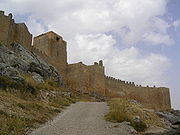
Arab Gormaz Castle
Encyclopedia

Location
The castle is located 13 kilometers south-east of El Burgo de Osma, at Gormaz, in the province of SoriaSoria (province)
Soria is a province of central Spain, in the eastern part of the autonomous community of Castile and León. Most of the province is in the mountainous Sistema Ibérico areaIt is bordered by the provinces of La Rioja, Zaragoza, Guadalajara, Segovia, and Burgos....
, in the autonomous community
Autonomous communities of Spain
An autonomous community In other languages of Spain:*Catalan/Valencian .*Galician .*Basque . The second article of the constitution recognizes the rights of "nationalities and regions" to self-government and declares the "indissoluble unity of the Spanish nation".Political power in Spain is...
of Castile-Leon, Spain
Spain
Spain , officially the Kingdom of Spain languages]] under the European Charter for Regional or Minority Languages. In each of these, Spain's official name is as follows:;;;;;;), is a country and member state of the European Union located in southwestern Europe on the Iberian Peninsula...
. It is situated north of the Duero river, placed on a hill that rises 100 m above the river level.
Features
The castle is more than 390 metres long, has 28 towers (originally at least 31), a main gate with a monumental horseshoe arch with remains of painted red and white voussoirVoussoir
A voussoir is a wedge-shaped element, typically a stone, used in building an arch or vault.Although each unit in an arch or vault is a voussoir, two units are of distinct functional importance: the keystone and the springer. The keystone is the center stone or masonry unit at the apex of an arch. A...
s, two postern
Postern
A postern is a secondary door or gate, particularly in a fortification such as a city wall or castle curtain wall. Posterns were often located in a concealed location, allowing the occupants to come and go inconspicuously. In the event of a siege, a postern could act as a sally port, allowing...
s, one of which with a small horseshoe arch, three mihrab
Mihrab
A mihrab is semicircular niche in the wall of a mosque that indicates the qibla; that is, the direction of the Kaaba in Mecca and hence the direction that Muslims should face when praying...
s corresponding to a "musalla" or open air collective oratory, use of "spolia
Spolia
Spolia is a modern art-historical term used to describe the re-use of earlier building material or decorative sculpture on new monuments...
e" of the Roman period, and the remains of a water pool near the monumental gate mentioned before. It was repaired in the 14th century, from which time date the remains of two gates on the southern side.
History
It was built shortly after 756 AD by emir Abd ar-Rahman IAbd ar-Rahman I
Abd al-Rahman I, or, his full name by patronymic record, Abd al-Rahman ibn Mu'awiya ibn Hisham ibn Abd al-Malik ibn Marwan was the founder of the Umayyad Emirate of Córdoba , a Muslim dynasty that ruled the greater part of Iberia for nearly three centuries...
of Córdoba, as part of a state ("dawla") policy to control rich landowners and peasants, as well as to try to govern and protect the Central Marches in the Douro Valley against the Christians to the North.
Surrounding area
Gormaz not only controls a contemporary bridge on the Duero, but it is in an area rich, in all directions, in watch-towers also of the middle of the 8th century AD and with some land-owners' towers such as the one that now serves as the belfry of the church of Bordecorex.The area is rich in relics from this period, near to Sepúlveda
Sepulveda
Sepúlveda is a name of families of Spanish descent. Sepúlveda, Segovia is the name of a village in Spain.The Sepúlveda family was prominent in the early days of Los Angeles, California and Orange County...
and Segovia
Segovia
Segovia is a city in Spain, the capital of Segovia Province in the autonomous community of Castile and León. It is situated north of Madrid, 30 minutes by high speed train. The municipality counts some 55,500 inhabitants.-Etymology:...
to the West, Ágreda
Ágreda
Ágreda is a town located in the province of Soria, Castile and León, Spain.Ágreda is the regional services center in the Northeast of the province of Soria. Its abundant heritage as well as the local fiestas of the Virgin, and the Archangel Michael attract a large number of tourists.-History:In the...
to the East, Berlanga de Duero
Berlanga de Duero
Berlanga de Duero is a municipality located in the province of Soria, Castile and León, Spain. According to the 2004 census , the municipality has a population of 1,099 inhabitants.-External links:* ** *...
to the Southeast. This is probably one of the oldest standing ensembles of military architecture in Western Europe.

